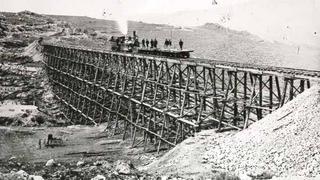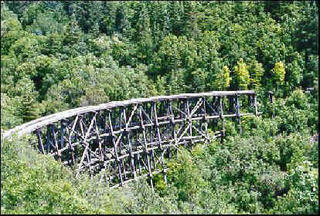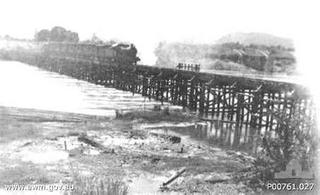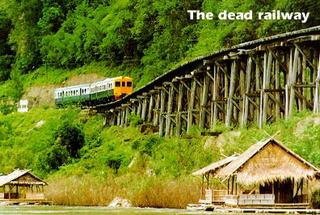Trestle.
This is coolbert:
In designing and building the wooden trestle used to test B-52 bombers [the whole gamut of USAF aircraft presumably in addition to the B-52 have been tested as well] for EMP protection, American engineers have resurrected an architecture form [wooden trestles] that reached it's zenith perhaps in the days of the old west.
When building the railroads that criss-crossed the old west in the years just after the American Civil War, railroad engineers of the era were faced with the difficult task of building bridges to span gorges, valleys, and rivers of stupendous size.
This type of engineering had been done by railroad engineers in the eastern states as well, but not on such a scale as was required in the American west. Everything just had to be bigger. Wooden trestle bridges of enormous size were designed and built and were employed successfully.
These structures were absolutely ESSENTIAL to the progress of the railroads toward the American west. The American old west could NOT have tamed and settled without this advancement in design and engineering. Wooden trestles of course were subject to the extremes of weather and were very susceptible to catching and fire and burning down. This did occur with frequency. A LOT of maintenance had to be done to keep the trestles in working order.

To this day, such trestle bridges, those that still exist, are popular tourist attractions. Building constructions of such size with WOOD just seems to be such an anachronism. That these constructs could even have been BUILT IN THE FIRST PLACE seems to us moderns to be difficult to fathom.

[persons designing and building large tall structures of such "natural" materials as wood and stone are faced with a real dilemma as they build higher and higher. The weight of the material stacked upon itself eventually will become too much for the lowest supporting members and cause the material at the bottom to crack and break just from the weight piled from above. You are usually limited with regard to how high you can build with wood or stone. You must be INGENIOUS AND IMAGINATIVE WITH YOUR DESIGN TO BUILD TALL AND HAVE THE STRUCTURE HOLD!! And remember, a railroad bridge not only has to support itself, it must also support a railroad train passing over with it's ponderous weight as well!!]
It should also be well understood that engineers of the time were mostly self-taught persons without the modern learning we associate with a civil engineer or an architect. These old-time engineers learned by O-J-T, apprenticeship, and just plain doing.
Nonetheless, there must have been a handbook available to such wooden trestle builders.
This handbook resurfaced during World War Two [WW2] and was put to good use by one of the major combatants.
The Japanese.
During the building of the "Railroad of Death" , the Malaya-Thai-Burma railroad, it was necessary for the Japanese engineers to build numerous wooden trestle bridges. This construction was done by hand, using numerous impressed British POW's and "native" laborers. Just as would have been done in the days of the old west in America. Rather than re-invent the wheel, the Japanese had available to them the American handbook on how to build wooden railroad trestle bridges. The designs contained with the book were used by the Japanese, using the excellent wood obtained from the surrounding jungle as building material.
Even possessing the designs, building the wooden trestle bridges was NOT easy. Impressed laborers do NOT make for good workers, and all conditions were made more difficult by the Japanese policy of SPEED-O!! That is to say, "get the bridge built, as fast as possible, without delay, and regardless to injury or danger to the workers". A lot of workers of all nationalities died as a result of the SPEED-O process.
[the very famous movie, "Bridge Over the River Kwai" is about the building of such a wooden trestle bridge.]

[in my estimation, the workers on the bridge did not have the institutional memory of how to build such bridges correctly and with relative ease. American builders in the old west would have had the institutional memory from having just built some many bridges. The Japanese had the plans, but not necessarily the know-how. The know-how had to be learned all over again, with great cost!!]
Nevertheless, these bridges were built and did carry trainloads of military supply over them. Becoming targets for Allied bomber aircraft operating out of the C-B-I [China-Burma-India] theatre.
Amazingly, it may be that some of these trestle bridges still exist are still going strong to this day??!!

To this day, the Kwai River bridge is a popular tourist destination in it's own right. Although it is not the wooden trestle bridge as seen in the movie. The background of the countryside is NOT the same as shown in the movie either. Open countryside, NOT the dense jungle as portrayed in the movie.
coolbert.

0 Comments:
Post a Comment
Subscribe to Post Comments [Atom]
<< Home